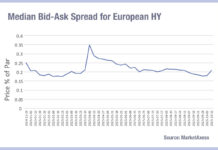 S&P Global Market Intelligence has assessed that the digital bond market “remains a work in progress” as new bond issuance focuses on testing in terms of demand and infrastructure.
S&P Global Market Intelligence has assessed that the digital bond market “remains a work in progress” as new bond issuance focuses on testing in terms of demand and infrastructure.
Issuance has comprised around US$1.5 billion in the past twelve months from virtually zero previously, according to the ratings agency. Crucially it has found that key market features are absent, including a secondary market for digital issuance, limiting digital bonds market liquidity. We could also see digital bonds denominated in digital currencies or stable coins, though we note that such instruments will be exposed to currency-related risks that will need to be considered in our rating analysis. “While it is still early days, digital bonds’ potential in terms of cost, security, and access to new sources of funding is evident. It is thus not surprising that issuers are testing the market,” wrote the S&P team, led by Mohamed Damak, primary credit analyst, in the paper entitled, ‘Digital Bonds: The Disruption Is Underway’.

“The broad advantages of digital bonds help explain why their emergence has not been concentrated in any specific geography or sector, and why we have seen issuance from both corporates and sovereigns. It is notable, however, that issuance has mainly been in developed markets. That can be attributed to the presence in those markets of intermediaries, which invested time and money, particularly in the past year, to build and test issuance and listing solutions.” As with the recent Siemens digital issuance, digital bonds promise to reduce or remove the role of intermediaries making issuance and management simpler and cheaper. “The most obvious way this will be done is by moving transactions to the blockchain – a digital ledger that will automatically, and without room for human error, document deals, payment instructions, and payments as they happen,” notes the paper. “The blockchain will also enable a real time view of the holders of a digital bond, improving an issuers capacity to interact with them as required.”
However, platform stability and the potential for platform providers to be ‘disrupted’ are an issue that S&P notes could be problematic. The use of off-chain, parallel data systems, with the ability to switch from digital bonds to a non-digital bonds are currently used to mitigate these risks. In 2022, S&P notes that total bond issuance was US$7.3 trillion, creating a big market to tackle. Several firms are already offering more efficient bond issuance technologies, including Bloomberg, dealer-backed Directbooks, Liquidnet and S&P’s own InvestorAccess. Dealers are also engaging in some digital issuance. “We have observed two models of issuance,” writes Damak. “The first, uses an issuance and management platform provided by a TradFi intermediary, such as those provided by Goldman Sachs or HSBC Orion.
The second model, has seen bonds list directly on a digital exchange, for example Six Digital Exchange (SDX), Deutsche Borse’s D7, or Marketnode. In the first option, the process typically consists of creating a digital representation of the bond (or the beneficial ownership in the bond) which is sold to investors and stored on the TradFi platform. In the second case, the bond is listed and stored on the digital exchange. The common feature of the two systems has been that cash transactions are rarely logged on the blockchain. “ Most transactions on these platforms materialise funds using a native token “coupled with traditional payments from a bank–generally the platform’s sponsor” while the bonds listed on digital exchanges have used traditional payment methods “not recorded on the blockchain”.
Consequently the team writes that it considers digital bonds already issued to be “only partially digital, notably because they continue to use traditional financial infrastructure and safeguards” while decentralised players and systems are still developing their offerings. “Evolving regulations, the use of CBDC and other stable tokens, and the emergence of tokenised deposits that can circulate on different blockchains will usher in further changes,” observes Damak. “They could include the listing of digital bonds on decentralized exchanges, and the emergence of digital players with compelling solutions for both bond issuers and investors.”
©Markets Media Europe 2023
©Markets Media Europe 2025
















